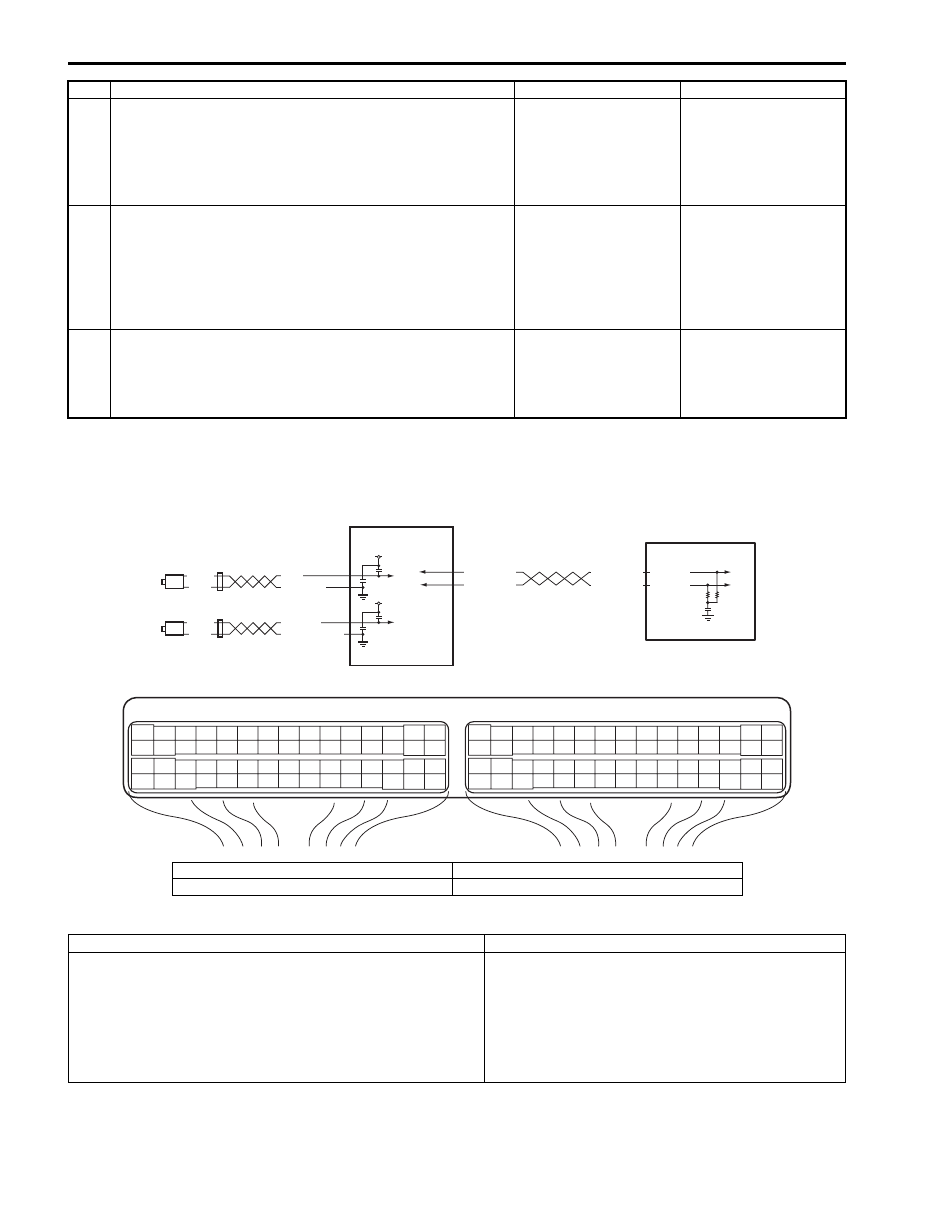Suzuki Grand Vitara JB416 / JB420. Manual — part 50

1A-149 Engine General Information and Diagnosis:
6
Wire circuit check
1) Measure voltage between “RED/BLK” wire terminal of
radiator cooling fan relay No.1 connector and vehicle
body ground with ignition switch turned ON.
Is voltage 0 V?
Go to Step 7.
“RED/BLK” wire is
shorted to other circuit.
7
Wire circuit check
1) Measure resistance between “RED/BLK” wire terminal of
radiator cooling fan relay No.1 connector and “E23-46”
terminal of ECM connector with ignition switch turned
OFF.
Is resistance below 2
Ω
?
Go to Step 20.
“RED/BLK” wire is open
circuit.
8
Wire circuit check
1) Disconnect connectors from ECM with ignition switch
turned OFF.
2) Measure voltage between “E23-47” terminal of ECM
connector and vehicle body ground with ignition switch
turned ON.
Is voltage 10 – 14 V?
Go to Step 9.
Go to Step 10.
9
Radiator cooling fan control No.2 check
1) Connect connectors to ECM with ignition switch turned
OFF.
2) Run engine until ECT is over 102.5
°C, 216.5 °F.
3) Measure voltage between “E23-47” terminal of ECM
connector and vehicle body ground.
Is voltage below 1.5 V?
Go to Step 14.
Substitute a known-
good ECM and recheck.
10 Wire circuit check
1) Disconnect radiator cooling fan relay No.2 (1) from relay
box (2) with ignition switch turned OFF.
2) Turn ON ignition switch.
3) Measure voltage between “YEL/GRN” wire terminal of
radiator cooling fan relay No.2 connector and vehicle
body ground.
Is voltage 10 – 14 V?
Go to Step 11.
“YEL/GRN” wire is open
circuit.
11 Wire circuit check
1) Measure resistance between “RED” wire terminal of
radiator cooling fan relay No.2 connector and vehicle
body ground with ignition switch turned OFF.
Is resistance infinity?
Go to Step 12.
“RED” wire is shorted to
ground circuit.
Step
Action
Yes
No
2
1
I5JB0A110058-02

Engine General Information and Diagnosis: 1A-150
12 Wire circuit check
1) Measure voltage between “RED” wire terminal of
radiator cooling fan relay No.2 connector and vehicle
body ground with ignition switch turned ON.
Is voltage 0 V?
Go to Step 13.
“RED” wire is shorted to
other circuit.
13 Wire circuit check
1) Measure resistance between “RED” wire terminal of
radiator cooling fan relay No.2 connector and “E23-47”
terminal of ECM connector with ignition switch turned
OFF.
Is resistance below 2
Ω
?
Go to Step 20.
“RED” wire is open
circuit.
14 Wire circuit check
1) Disconnect connectors from ECM with ignition switch
turned OFF.
2) Measure voltage between “E23-48” terminal of ECM
connector and vehicle body ground with ignition switch
turned ON.
Is voltage 10 – 14 V?
Go to Step 15.
Go to Step 16.
15 Radiator cooling fan control No.3 check
1) Connect connectors to ECM with ignition switch turned
OFF.
2) Run engine until ECT is over 102.5
°C, 216.5 °F.
3) Measure voltage between “E23-48” terminal of ECM
connector and vehicle body ground.
Is voltage below 1.5 V?
Intermittent trouble.
Check for intermittent
referring to “Intermittent
and Poor Connection
Inspection in Section
00”.
Substitute a known-
good ECM and recheck.
16 Wire circuit check
1) Disconnect radiator cooling fan relay No.3 (1) from relay
box (2) with ignition switch turned OFF.
2) Turn ON ignition switch.
3) Measure voltage between “YEL/GRN” wire terminal of
radiator cooling fan relay No.3 connector and vehicle
body ground.
Is voltage 10 – 14 V?
Go to Step 17.
“YEL/GRN” wire is open
circuit.
17 Wire circuit check
1) Measure resistance between “RED/YEL” wire terminal of
radiator cooling fan relay No.3 connector and vehicle
body ground with ignition switch turned OFF.
Is resistance infinity?
Go to Step 18.
“RED/YEL” wire is
shorted to ground
circuit.
Step
Action
Yes
No
1
2
I5JB0A110059-02

1A-151 Engine General Information and Diagnosis:
DTC P0500: Vehicle Speed Sensor (VSS) Malfunction
S5JB0A1104049
Wiring Diagram
DTC Detecting Condition and Trouble Area
18 Wire circuit check
1) Measure voltage between “RED/YEL” wire terminal of
radiator cooling fan relay No.3 connector and vehicle
body ground with ignition switch turned ON.
Is voltage 0 V?
Go to Step 19.
“RED/YEL” wire is
shorted to other circuit.
19 Wire circuit check
1) Measure resistance between “RED/YEL” wire terminal of
radiator cooling fan relay No.3 connector and “E23-48”
terminal of ECM connector with ignition switch turned
OFF.
Is resistance below 5
Ω
?
Go to Step 20.
“RED/YEL” wire is open
circuit
20 Radiator cooling fan relay check
1) Check radiator cooling fan relay referring to “Radiator
Cooling Fan Relay Inspection in Section 1F”.
Is it in good condition?
Substitute a known-
good ECM and recheck.
Replace relay.
Step
Action
Yes
No
E23-4
E23-19
WHT/RED
WHT/BLU
WHT/RED
WHT/BLU
E23
C37
3
4
18
19
5
6
7
10
11
17
20
47
46
49
50
51
21
22
52
16
25
9
24
14
29
55
57
54 53
59
60
58
2
26
27
28
15
30
56
48
32
31
34
35
36
37
40
42
39 38
44
45
43
41
33
1
12
13
23
8
3
4
18
19
5
6
7
10
11
17
20
47
46
49
50
51
21
22
52
16
25
9
24
14
29
55
57
54 53
59
60
58
2
26
27
28
15
30
56
48
32
31
34
35
36
37
40
42
39 38
44
45
43
41
33
1
12
13
23
8
BLK
WHT
BLK
WHT
YEL/BLK
YEL
LT GRN
LT GRN/BLK
12V
12V
1
2
3
4
I5JB0A110060-03
1. Rear left side wheel speed sensor (VSS 1)
3. ABS hydraulic unit / control module Assembly
2. Rear right side wheel speed sensor (VSS 2)
4. ECM
DTC detecting condition
Trouble area
• Vehicle speed signal is not input while fuel is cut at
deceleration for 4 seconds continuously at 3600 rpm or
less.
• Vehicle speed signal is not input even if engine is running
with more than 3700 rpm at D-Range for 4 sec. (for A/T
model).
(2 driving cycle detection logic)
• Wheel speed sensor (VSS)
• Wheel speed sensor circuit
• ABS hydraulic unit / control module assembly
• ECM

Engine General Information and Diagnosis: 1A-152
DTC Confirmation Procedure
WARNING
!
• When performing a road test, select a place where there is no traffic or possibility of a traffic
accident and be very careful during testing to avoid occurrence of an accident.
• Road test should be carried out by 2 persons, a driver and a tester.
1) With ignition switch turned OFF, connect scan tool.
2) Turn ON ignition switch and clear DTC using scan tool.
3) Warm up engine to normal operating temperature.
4) Drive vehicle at 4000 rpm (engine speed) with 3rd gear (for M/T vehicle) or “3” range (for A/T vehicle).
5) Release accelerator pedal and with engine brake applied, keep vehicle coasting for 6 sec. or more (fuel cut
condition for 5 sec. or more) and stop vehicle.
6) For A/T model, drive vehicle at more than 3700 rpm for 10 sec.
7) Check pending DTC and DTC.
DTC Troubleshooting
NOTE
Before this trouble shooting is performed, read the precautions for DTC troubleshooting referring to
“Precautions For DTC Troubleshooting”.
Step
Action
Yes
No
1
Was “Engine and Emission Control System Check”
performed?
Go to Step 2.
Go to “Engine and
Emission Control
System Check”.
2
Vehicle speed signal check
Is vehicle speed displayed on scan tool in Step 4) and 5) of
“DTC Confirmation Procedure”?
Intermittent trouble.
Check for intermittent
referring to “Intermittent
and Poor Connection
Inspection in Section
00”.
Go to Step 3.
3
DTC check in ABS hydraulic unit / control module
assembly
1) Connect scan tool to DLC with ignition switch turned
OFF.
2) Check ABS hydraulic unit / control module assembly for
DTC.
Is there any DTDC(s) in ABS hydraulic unit / control module
assembly?
Go to applicable DTC
diag. flow.
Substitute a known-
good ECM and recheck.

Нет комментариевНе стесняйтесь поделиться с нами вашим ценным мнением.
Текст